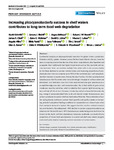Increasing picocyanobacteria success in shelf waters contributes to long-term food web degradation
| dc.contributor.author | Schmidt, Katrin | |
| dc.contributor.author | Birchill, AJ | |
| dc.contributor.author | Atkinson, A | |
| dc.contributor.author | Brewin, RJW | |
| dc.contributor.author | Clark, JR | |
| dc.contributor.author | Hickman, AE | |
| dc.contributor.author | Johns, DG | |
| dc.contributor.author | Lohan, MC | |
| dc.contributor.author | Milne, Angela | |
| dc.contributor.author | Pardo, S | |
| dc.contributor.author | Polimene, L | |
| dc.contributor.author | Smyth, TJ | |
| dc.contributor.author | Tarran, GA | |
| dc.contributor.author | Widdicombe, CE | |
| dc.contributor.author | Woodward, EMS | |
| dc.contributor.author | Ussher, Simon | |
| dc.date.accessioned | 2020-07-01T15:22:03Z | |
| dc.date.issued | 2020-06-07 | |
| dc.identifier.issn | 1354-1013 | |
| dc.identifier.issn | 1365-2486 | |
| dc.identifier.uri | http://hdl.handle.net/10026.1/15824 | |
| dc.description.abstract |
<jats:title>Abstract</jats:title><jats:p>Continental margins are disproportionally important for global primary production, fisheries and CO<jats:sub>2</jats:sub> uptake. However, across the Northeast Atlantic shelves, there has been an ongoing summertime decline of key biota—large diatoms, dinoflagellates and copepods—that traditionally fuel higher tropic levels such as fish, sea birds and marine mammals. Here, we combine multiple time series with in situ process studies to link these declines to summer nutrient stress and increasing proportions of picophytoplankton that can comprise up to 90% of the combined pico‐ and nanophytoplankton biomass in coastal areas. Among the pico‐fraction, it is the cyanobacterium <jats:italic>Synechococcus</jats:italic> that flourishes when iron and nitrogen resupply to surface waters are diminished. Our field data show how traits beyond small size give <jats:italic>Synechococcus</jats:italic> a competitive edge over pico‐ and nanoeukaryotes. Key is their ability to grow at low irradiances near the nutricline, which is aided by their superior light‐harvesting system and high affinity to iron. However, minute size and lack of essential biomolecules (e.g. omega‐3 polyunsaturated fatty acids and sterols) render <jats:italic>Synechococcus</jats:italic> poor primary producers to sustain shelf sea food webs efficiently. The combination of earlier spring blooms and lower summer food quantity and quality creates an increasing period of suboptimal feeding conditions for zooplankton at a time of year when their metabolic demand is highest. We suggest that this nutrition‐related mismatch has contributed to the widespread, ~50% decline in summer copepod abundance we observe over the last 60 years. With <jats:italic>Synechococcus</jats:italic> clades being prominent from the tropics to the Arctic and their abundances increasing worldwide, our study informs projections of future food web dynamics in coastal and shelf areas where droughts and stratification lead to increasing nutrient starvation of surface waters.</jats:p> | |
| dc.format.extent | 5574-5587 | |
| dc.format.medium | Print-Electronic | |
| dc.language | en | |
| dc.language.iso | en | |
| dc.publisher | Wiley | |
| dc.subject | climate change | |
| dc.subject | copepods | |
| dc.subject | food quality | |
| dc.subject | iron | |
| dc.subject | nitrate | |
| dc.subject | picoeukaryotes | |
| dc.subject | stratification | |
| dc.subject | Synechococcus | |
| dc.subject | time series | |
| dc.subject | Western Channel Observatory | |
| dc.title | Increasing picocyanobacteria success in shelf waters contributes to long-term food web degradation | |
| dc.type | journal-article | |
| dc.type | Journal Article | |
| plymouth.author-url | https://www.webofscience.com/api/gateway?GWVersion=2&SrcApp=PARTNER_APP&SrcAuth=LinksAMR&KeyUT=WOS:000538327900001&DestLinkType=FullRecord&DestApp=ALL_WOS&UsrCustomerID=11bb513d99f797142bcfeffcc58ea008 | |
| plymouth.issue | 10 | |
| plymouth.volume | 26 | |
| plymouth.publication-status | Published | |
| plymouth.journal | Global Change Biology | |
| dc.identifier.doi | 10.1111/gcb.15161 | |
| plymouth.organisational-group | /Plymouth | |
| plymouth.organisational-group | /Plymouth/Faculty of Science and Engineering | |
| plymouth.organisational-group | /Plymouth/Faculty of Science and Engineering/School of Geography, Earth and Environmental Sciences | |
| plymouth.organisational-group | /Plymouth/REF 2021 Researchers by UoA | |
| plymouth.organisational-group | /Plymouth/REF 2021 Researchers by UoA/UoA07 Earth Systems and Environmental Sciences | |
| plymouth.organisational-group | /Plymouth/Research Groups | |
| plymouth.organisational-group | /Plymouth/Research Groups/BEACh | |
| plymouth.organisational-group | /Plymouth/Research Groups/Marine Institute | |
| plymouth.organisational-group | /Plymouth/Users by role | |
| plymouth.organisational-group | /Plymouth/Users by role/Academics | |
| plymouth.organisational-group | /Plymouth/Users by role/Researchers in ResearchFish submission | |
| dc.publisher.place | England | |
| dcterms.dateAccepted | 2020-04-24 | |
| dc.rights.embargodate | 2020-7-3 | |
| dc.identifier.eissn | 1365-2486 | |
| dc.rights.embargoperiod | Not known | |
| rioxxterms.versionofrecord | 10.1111/gcb.15161 | |
| rioxxterms.licenseref.uri | http://www.rioxx.net/licenses/all-rights-reserved | |
| rioxxterms.licenseref.startdate | 2020-06-07 | |
| rioxxterms.type | Journal Article/Review | |
| plymouth.funder | Processes Influencing Carbon Cycling: Observations of the Lower limb of the Antarctic Overturning (PICCOLO)::NERC | |
| plymouth.funder | Processes Influencing Carbon Cycling: Observations of the Lower limb of the Antarctic Overturning (PICCOLO)::NERC | |
| plymouth.funder | Processes Influencing Carbon Cycling: Observations of the Lower limb of the Antarctic Overturning (PICCOLO)::NERC | |
| plymouth.funder | Processes Influencing Carbon Cycling: Observations of the Lower limb of the Antarctic Overturning (PICCOLO)::NERC |


